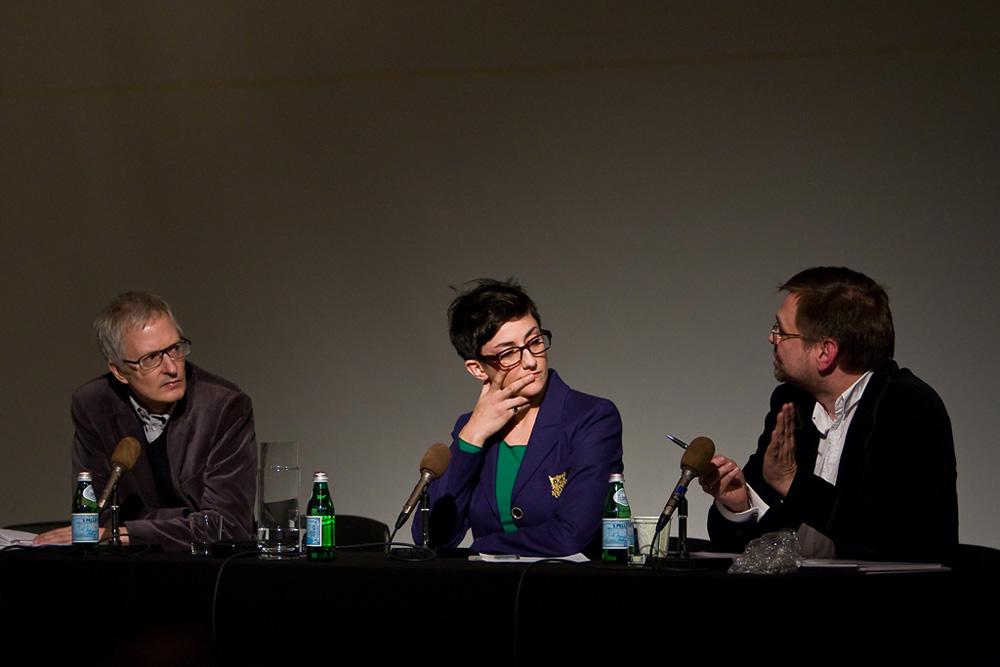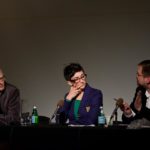Tirdad Zolghadr led the proceedings off with a keynote address on the Friday night. An Iranian-born curator based in Berlin, Zolghadr is an accomplished speaker and trenchant critic. He used rhetoric and analytical acumen like a chainsaw to cut through the po-mo truisms and clichés of contemporary criticism. Indeed, Zolghadr’s turns of phrase alone were worth the price of admission: he referred to his occupation as critic and curator as “crittor,” juxtaposed Jacuzzis and j’accuses, spoke of post-structuralistas and “binary fluffing,” and lumped together Bill Gates, Francis Fukuyama and the Israeli Defence Force.
Thus Zolghadr offered a “crisisology” of current demands for judgment (as in James Elkins’s denigration of description in art writing in his 2003 pamphlet What Happened to Art Criticism?), seeing in those demands little more than a nostalgic call to arms. A pleasure to listen to, Zolghadr’s talk was nonetheless contentious, particularly when he said that critics should sometimes shut up, and avoid moving into philosophical or political arenas in which they have little training. Too, his diagnosis of “binary fluffing” (or cheap paradoxes like Irit Rogoff’s “a theorist is one who has been undone by theory”) was made in ignorance of the porn meaning of “fluffing” (maintaining the male performer’s erection) and could be taken as a disavowal of the libidinal. But Zolghadr’s talk was received with great interest, and the Q and A continued for a good hour.
And so appetites were whetted for an intellectually challenging weekend, and the two sessions on Saturday met the audience’s expectations. (It’s worth noting that there was a standing-room-only crowd in a theatre that held 300 for Zolghadr’s talk; the room also filled on the Saturday.) The morning panel, on judgment in the art review, featured UBC art historians William Wood and John O’Brian, Frieze editor and London curator Tom Morton and Vancouver artist Kristina Lee Podesva.
Wood began the morning session with a fine historicization of debates in art criticism, referring particularly to a roundtable in October and the Hegelian endgame of Arthur Danto’s pronouncements on the end of art. (Although given Wood’s views on relational aesthetics, he probably wishes art had ended.) Morton was rather underwhelming; he called for intimacy in art criticism, defending Frieze’s belle-lettrisme. Podesva, an editor at Fillip, engaged with the question of audiences and publics and their relation to art writing; O’Brian, in a manner suiting his scholarship on Clement Greenberg, acted as avuncular moderator.
The afternoon session was chaired by Vancouver poet Jeff Derksen, who has been writing about art for more than 20 years. The panellists, Goldsmiths director of art writing Maria Fusco and Vienna Academy of Art professor Diedrich Diederichsen, dealt respectively with experimentalism in art criticism and the question of how to contextualize aesthetic judgment. Fusco’s text was a pornographic—and perhaps fictitious—account of an art critic trying to get images for an article on Cosey Fanni Tutti. Besides capturing perfectly the milquetoast power games that beset the art world, it showed how art criticism can move beyond description or judgment and into new textual modes. Diederichsen closed the proceedings with a witty and rigorous juxtaposition of art judgment against the popular, first comparing art openings to The Simpsons. Diederichsen’s paper then moved between the aesthetic criteria of the pop fan and that of the art lover in a bravura piece of analysis, invoking heavy philosophical notions of the temporal dimensions of the artwork: the MP3 file that does not exist in time and the work of art that exists for all time. This must have had Adorno simultaneously rolling in his grave and rooting for his long-lost son.
In all, within a 24-hour period—not counting rehashes in local bars—Judgment and Contemporary Art Criticism succeeded in bringing an energetic set of thinkers together, providing both locals and guests with a new set of questions and a renewed interest in the role of the critic. So of course I’ll end with a couple of reservations. The range of critical voices that were referenced was perhaps narrow: Boris Groys, Michael Fried, Clement Greenberg and Benjamin Buchloh dominating, with a minor role for Andrea Fraser, Michel Foucault, Pierre Bourdieu and Judith Butler. So it was all still very much within the problematic of institutional critique, and, to this observer at least, very much lacking in any discussion of subject positions, of pleasure, of psychoanalysis: no Freud, no Kristeva, no Lacan, no Zizek.
And it was only on my way home in the Saturday twilight that it occurred to me why so many artists were filling the seats in the Emily Carr auditorium: art critics in town. Studio visits. Of course.

 The Saturday afternoon panel at the Judgment and Contemporary Art Criticism symposium (from left) Jeff Derksen, Maria Fusco & Diedrich Diederichsen / photo Blaine Campbell
The Saturday afternoon panel at the Judgment and Contemporary Art Criticism symposium (from left) Jeff Derksen, Maria Fusco & Diedrich Diederichsen / photo Blaine Campbell








